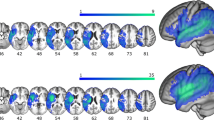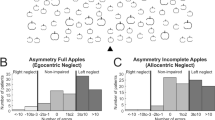Abstract
Unilateral spatial neglect (USN) results from impaired attentional networks and can affect various sensory modalities, such as visual and somatosensory. The rodent medial agranular cortex (AGm), located in the medial part of the forebrain from rostral to caudal direction, is considered a region associated with spatial attention. The AGm selectively receives multisensory input with the rostral AGm receiving somatosensory input and caudal part receiving visual input. Our previous study showed slower recovery from neglect with anterior AGm lesion using the somatosensory neglect assessment. Conversely, the functional differences in spatial attention across the entire AGm locations (anterior, intermediate, and posterior parts) are unknown. Here, we investigated the relationship between the severity of neglect and various locations across the entire AGm in a mouse stroke model using a newly developed program-based analysis method that does not require human intervention. Among various positions of the lesions, the recovery from USN during recovery periods (postoperative day; POD 10–18) tended to be slower in cases with more rostral lesions in the AGm (r = − 0.302; p = 0.028). Moreover, the total number of arm entries and maximum moving speed did not significantly differ between before and after AGm infarction. According to these results, the anterior lesions may slowly recover from USN-like behavior, and there may be a weak association between the AGm infarct site and recovery rate. In addition, all unilateral focal infarctions in the AGm induced USN-like behavior without motor deficits.



Similar content being viewed by others
Data availability
Data sets generated during the current study are available from the corresponding author on reasonable request.
References
Barthas F, Kwan AC (2017) Secondary motor cortex: where ‘Sensory’ meets ‘Motor’ in the Rodent Frontal Cortex. Trends Neurosci 40:181–193. https://doi.org/10.1016/j.tins.2016.11.006
Bechay KR, Abduljawad N, Latifi S, Suzuki K, Iwashita H, Carmichael ST (2022) PDE2A inhibition enhances Axonal Sprouting, Functional Connectivity, and recovery after Stroke. J Neurosci 42:8225–8236. https://doi.org/10.1523/JNEUROSCI.0730-22.2022
Caracciolo L, Marosi M, Mazzitelli J et al (2018) CREB controls cortical circuit plasticity and functional recovery after stroke. Nat Commun 9:2250. https://doi.org/10.1038/s41467-018-04445-9
Carandini M, Churchland AK (2013) Probing perceptual decisions in rodents. Nat Neurosci 16:824–831. https://doi.org/10.1038/nn.3410
Diedenhofen B, Musch J (2015) Cocor: a comprehensive solution for the statistical comparison of correlations. PLoS ONE 10:e0121945. https://doi.org/10.1371/journal.pone.0121945
Erlich JC, Brunton BW, Duan CA, Hanks TD, Brody CD (2015) Distinct effects of prefrontal and parietal cortex inactivations on an accumulation of evidence task in the rat. Elife 4. https://doi.org/10.7554/eLife.05457
Fukui A, Osaki H, Ueta Y, Kobayashi K, Muragaki Y, Kawamata T, Miyata M (2020) Layer-specific sensory processing impairment in the primary somatosensory cortex after motor cortex infarction. Sci Rep 10:3771. https://doi.org/10.1038/s41598-020-60662-7
Gillen R, Tennen H, McKee T (2005) Unilateral spatial neglect: relation to rehabilitation outcomes in patients with right hemisphere stroke. Arch Phys Med Rehabil 86:763–767. https://doi.org/10.1016/j.apmr.2004.10.029
Harvey CD, Coen P, Tank DW (2012) Choice-specific sequences in parietal cortex during a virtual-navigation decision task. Nature 484:62–68. https://doi.org/10.1038/nature10918
Heilman KM, Valenstein E, Watson RT (2000) Neglect and related disorders. Semin Neurol 20:463–470. https://doi.org/10.1055/s-2000-13179
Ishii D, Osaki H, Yozu A et al (2021) Ipsilesional spatial bias after a focal cerebral infarction in the medial agranular cortex: a mouse model of unilateral spatial neglect. Behav Brain Res 401:113097. https://doi.org/10.1016/j.bbr.2020.113097
King V, Corwin J (1990a) Neglect following unilateral ablation of the caudal but not the rostral portion of medial agranular cortex of the rat and the therapeutic effect of apomorphine. Behav Brain Res 37:169–184
King V, Corwin JV (1990b) Neglect following unilateral ablation of the caudal but not the rostral portion of medial agranular cortex of the rat and the therapeutic effect of apomorphine. Behav Brain Res 37:169–184. https://doi.org/10.1016/0166-4328(90)90092-s
King VR, Corwin JV (1993) Comparisons of hemi-inattention produced by unilateral lesions of the posterior parietal cortex or medial agranular prefrontal cortex in rats: neglect, extinction, and the role of stimulus distance. Behav Brain Res 54:117–131. https://doi.org/10.1016/0166-4328(93)90070-7
Lee JK, Park MS, Kim YS et al (2007) Photochemically induced cerebral ischemia in a mouse model. Surg Neurol 67:620–625 discussion 625. https://doi.org/10.1016/j.surneu.2006.08.077
Luo P, Li A, Zheng Y et al (2019) Whole brain mapping of long-range direct input to Glutamatergic and GABAergic neurons in Motor Cortex. Front Neuroanat 13:44. https://doi.org/10.3389/fnana.2019.00044
Manita S, Suzuki T, Homma C et al (2015) A Top-Down Cortical Circuit for accurate sensory perception. Neuron 86:1304–1316. https://doi.org/10.1016/j.neuron.2015.05.006
Manita S, Miyakawa H, Kitamura K, Murayama M (2017) Dendritic spikes in sensory perception. Front Cell Neurosci 11:29. https://doi.org/10.3389/fncel.2017.00029
Murakami M, Vicente MI, Costa GM, Mainen ZF (2014) Neural antecedents of self-initiated actions in secondary motor cortex. Nat Neurosci 17:1574–1582. https://doi.org/10.1038/nn.3826
Reep RL, Goodwin GS, Corwin JV (1990) Topographic organization in the corticocortical connections of medial agranular cortex in rats. J Comp Neurol 294:262–280. https://doi.org/10.1002/cne.902940210
Ringman JM, Saver JL, Woolson RF, Clarke WR, Adams HP (2004) Frequency, risk factors, anatomy, and course of unilateral neglect in an acute stroke cohort. Neurology 63:468–474. https://doi.org/10.1212/01.wnl.0000133011.10689.ce
Sul JH, Jo S, Lee D, Jung MW (2011) Role of rodent secondary motor cortex in value-based action selection. Nat Neurosci 14:1202–1208. https://doi.org/10.1038/nn.2881
Van Eden CG, Lamme VA, Uylings HB (1992) Heterotopic cortical afferents to the Medial Prefrontal Cortex in the rat. A combined Retrograde and Anterograde Tracer Study. Eur J Neurosci 4:77–97. https://doi.org/10.1111/j.1460-9568.1992.tb00111.x
Vargo JM, Corwin JV, King V, Reep RL (1988) Hemispheric asymmetry in neglect produced by unilateral lesions of dorsomedial prefrontal cortex in rats. Exp Neurol 102:199–209. https://doi.org/10.1016/0014-4886(88)90094-5
Watson BD, Dietrich WD, Busto R, Wachtel MS, Ginsberg MD (1985) Induction of reproducible brain infarction by photochemically initiated thrombosis. Ann Neurol 17:497–504. https://doi.org/10.1002/ana.410170513
Funding
This work was supported by JSPS KAKENHI (Nos. 18K17725 and 22K19758 to Dr. Ishii; No. 22H04784 to Dr. Osaki; and No. 19H05730 to Dr. Yozu).
Author information
Authors and Affiliations
Contributions
DI, HO, AY, and TY conceived and designed the experiments. DI, HO, and TY collected and analyzed the data. DI, HO, TY, SY, and MM wrote the manuscript. MM and YK supervised all studies. All authors reviewed and revised the manuscript.
Corresponding author
Ethics declarations
The authors declare no competing interests. All experiments were performed in accordance with the “Guidelines for the Proper Conduct of Animal Experiments” established by the Science Council of Japan in 2006, and were approved by the Animal Care and Use Committee of Ibaraki Prefectural University of Health Sciences (approval number 2022-14).
Additional information
Communicated by Melvyn A. Goodale.
Publisher’s Note
Springer Nature remains neutral with regard to jurisdictional claims in published maps and institutional affiliations.
Electronic supplementary material
Below is the link to the electronic supplementary material.
Rights and permissions
Springer Nature or its licensor (e.g. a society or other partner) holds exclusive rights to this article under a publishing agreement with the author(s) or other rightsholder(s); author self-archiving of the accepted manuscript version of this article is solely governed by the terms of such publishing agreement and applicable law.
About this article
Cite this article
Ishii, D., Osaki, H., Yozu, A. et al. Role of the medial agranular cortex in unilateral spatial neglect. Exp Brain Res (2024). https://doi.org/10.1007/s00221-024-06817-8
Received:
Accepted:
Published:
DOI: https://doi.org/10.1007/s00221-024-06817-8




